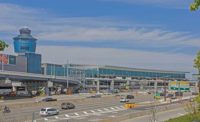ENR Northwest 2024 Best Projects
Northwest Project of the Year Finalist, Best Airport/Transit: Seattle Multimodal Terminal at Colman Dock

Photo by Marissa Lordahl/Hoffman Construction
SEATTLE MULTIMODAL TERMINAL AT COLMAN DOCK
Seattle
BEST PROJECT, AIRPORT/TRANSIT
Submitted by: Hoffman Construction
OWNER: Washington State Ferries, WSDOT
LEAD DESIGN FIRM: WSP USA
GENERAL CONTRACTOR: Hoffman-Pacific LLC, a Joint Venture
First built in 1882, Colman Dock has overcome multiple adversities during its long history, from the Great Seattle Fire of 1889 to a collision with the Alameda, a steel-hulled ship, in 1912. Today, Colman Dock is the busiest ferry terminal in Washington, with more than 10 million passengers annually. Completed on time and within budget in September 2023 after eight years of construction, this $367-million project updated the regional multimodal transportation hub, replacing aging and seismically vulnerable wood piles and trestle foundations with steel for strength and longevity.
Under the project’s scope, existing ferry terminal and passenger facilities were demolished and rebuilt, and 7,400 tons of creosote-treated timber piles were removed from Elliott Bay, opening an area of shoreline and near-shore habitat. The project team added an overhead loading area and walkway, an 8,500-sq-ft passenger-only ferry building and a 23,000-sq-ft LEED Silver terminal building.

Photo courtesy Hoffman Construction
To keep construction moving at a steady pace, the project team resequenced work, allowing for smoother transitions between phases. For example, strategically deferring the construction of the terminal building resulted in an opportunity to eliminate conflicts between trestle demolition and reconstruction.
Maintaining uninterrupted ferry operations was vital to the project’s success. As construction progressed at various points on the trestle, crews rerouted traffic to facilitate both construction work and continuous traffic flow. This coordinated approach allowed for the seamless progression of construction activities without affecting vital ferry operations.

Photo courtesy Hoffman Construction
To complete utility installations underneath Colman Dock’s precast concrete trestles, the project team pioneered the use of pontoon boats with drill-powered lift pods, providing a stable, adjustable platform that responded to tidal changes. This solution enhanced safety and accuracy, allowing crews to work continuously through tidal swings as wide as 14 ft. Meanwhile, comprehensive laser scanning underneath the terminal completed during preconstruction facilitated work over the water as well, ensuring precise alignment of the newly installed beams amid the existing pile caps.
A modular steel bridge provided a detour for pedestrians as construction progressed, allowing safe passage over an active jobsite and multiple lanes of traffic. To build the 270-ft-long, two-span bridge on the dock, there could be no heavy point loads. Temporary shoring supported the structure during installation in 2019 and remained in use until November 2023. This highway-rated structure was designed for future use as well.

Photo courtesy Hoffman Construction
After local strikes impacted concrete supplies to the jobsite in early 2022, the contractor swiftly pivoted, redirecting focus toward critical path items that were not dependent on concrete. This mitigated schedule and cost impacts while also allowing crews to maintain momentum until the strikes concluded, at which point the team resequenced work to navigate any strike-related delays.



